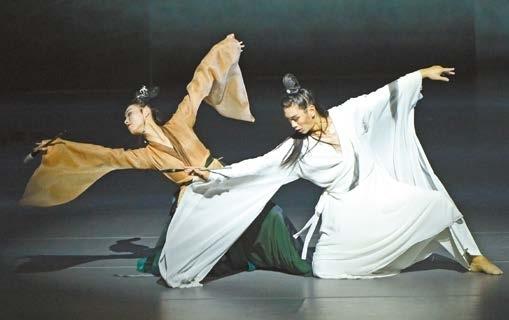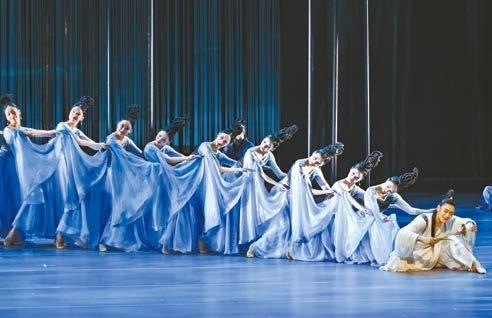

SHANGHAI Opera House’s dance drama, “Dance of Calligraphy in 353 A.D.,” will greet local audiences at Pingshan Theater later this year. This production explores the world of Chinese calligraphy, conveying its aesthetic and romantic qualities through dance. It premiered at the Shanghai International Arts Festival in November 2023 and has since toured numerous Chinese cities. The drama draws inspiration from “Lantingji Xu” (“Preface to the Poems Composed at the Orchid Pavilion”), penned by Chinese calligrapher Wang Xizhi (303-361) while inebriated 1,670 years ago. Wang was a master of all calligraphy styles, especially the running script. “Lantingji Xu” was written on cocoon paper using a weasel-whisker brush in the running style, consisting of 324 characters across 28 columns. The piece is widely regarded as a pinnacle of Chinese calligraphy. Directed and choreographed by Wang Yabin, the dance drama offers a contemporary interpretation of the ancient origins and lasting legacy of this calligraphic masterpiece. Wang Yabin explains that the greatest challenge in creating the show was translating the subtlety of ancient ink art into expressive dance movements. The dance drama begins with a young man embarking on a journey into the world of this calligraphy work. Set amid lush bamboo forests, the modern-day protagonist time-travels to ancient China, where Wang Xizhi created his iconic work. Male dancers perform to the rhythmic beats of drums, with calligraphy projected on a screen behind them. Calligraphic elements are integrated into the visuals, with dancers’ dynamic movements mimicking brush strokes. Supported by multimedia technology, the stage transforms to depict various scenes, including bamboo groves, streams, warfare, and the imperial court. Li Shimin, posthumously known as Emperor Taizong of the Tang Dynasty (618-907), admired Wang Xizhi’s calligraphy and collected many of his works. It is said that the original “Lantingji Xu” was buried with the emperor. In the drama, the young man also travels to the Tang Dynasty to witness the emperor’s admiration for the calligraphy. Legend has it that Wang Xizhi drew inspiration from nature, including the graceful neck movements of geese. To reflect this, director Wang Yabin created a goose character performed by a principal dancer from the Shanghai Opera House troupe. Composer Lyu Liang used the seven-stringed guqin as the solo instrument in his score. Other traditional Chinese instruments — including the pipa (lute), zheng (Chinese board zither), xiao (vertical bamboo flute), xun (clay ocarina), and erhu (two-stringed bowed instrument) — combine to create a rich soundscape that enhances the narrative. Time: 3 p.m., Sept. 13 Tickets: 80-480 yuan Venue: Pingshan Theater, Pingshan District (坪山大剧院) Metro: Line 14 to Pingshan Square Station (坪山广场站), Exit D1(Li Dan) | 
